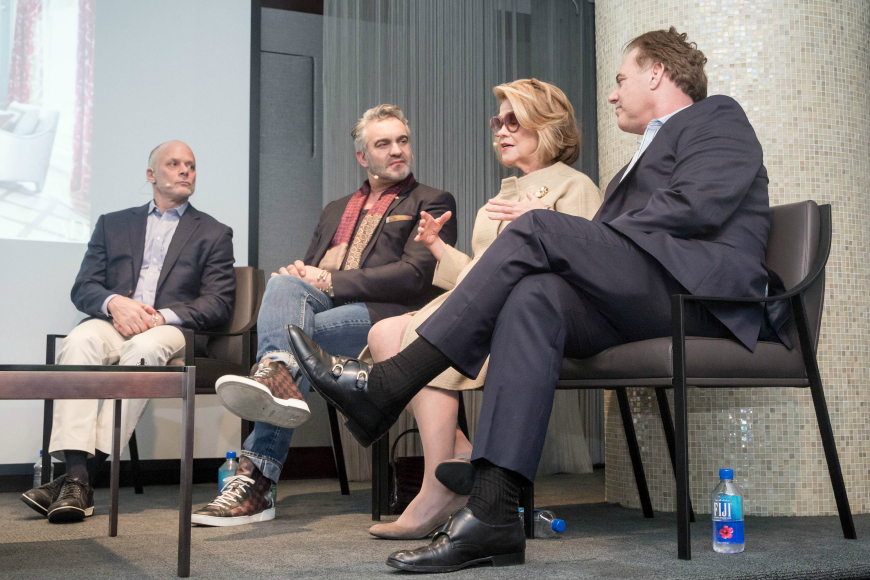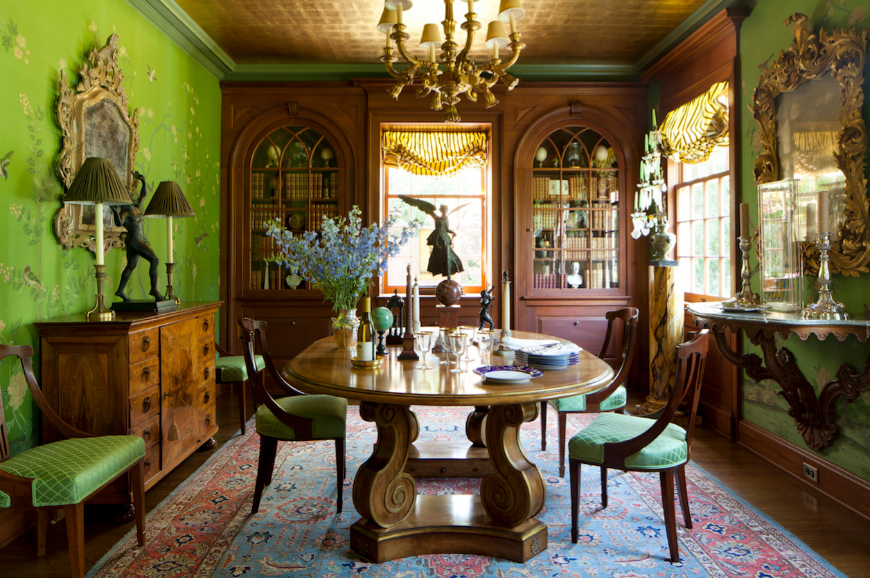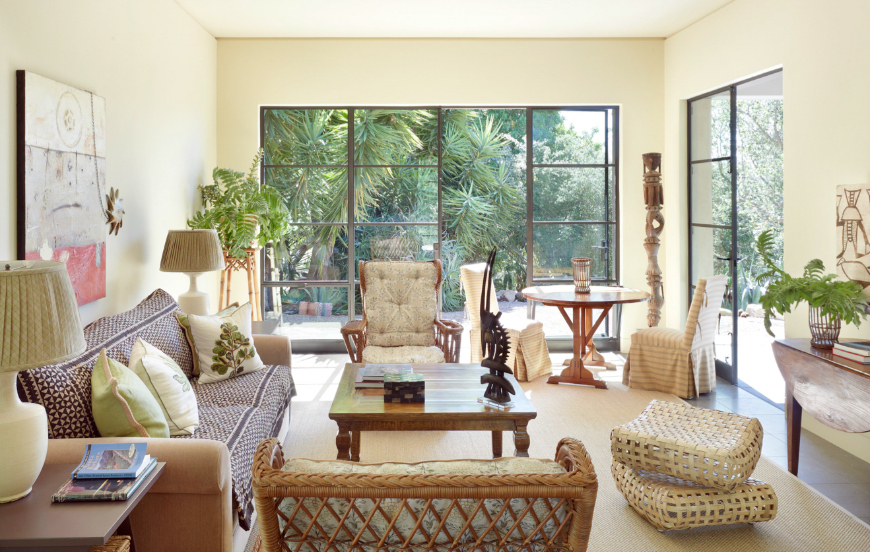
Since its publication six months ago, there has been much buzz surrounding Carl Dellatore‘s Interior Design Master Class. To continue the celebration of the highly educational publication, Traditional Home style editor Krissa Rossbund moderated a discussion with Carl and three decorative arts icons who penned essays in the book: Hollyhock owner Suzanne Rheinstein, who is known for a signature style that many describe as elegant civility; Timothy Corrigan, who has design offices in Los Angeles and Paris, and has created licensed collections with seven partners; and British designer Martyn Lawrence Bullard, who is recognized for his broad range of eclectic yet sophisticated styles. The second keynote of WESTWEEK 2017 at the PDC, titled “Conversation Pieces of ‘Design Master Class,'” touched on a great deal of topics—including the tome’s backstory, how sex and interiors coincide, and what the designer-in-training really needs to pay attention to.
How did the book come to fruition?
Carl Dellatore: My textile line, CJ Dellatore Textile, became an unfortunate casualty of the recession, and I found myself in need of a reinvention. I had [one book] down [after] the column with Marian [McEvoy, then editor in chief] at House Beautiful. [The column, “Swatch Watch,” was compiled in The Fabric Style Book in 2007.] I really loved that work, so this book was born out of that need for reinvention. I thought, What would I really like to be doing with my life? I thought, I’d love to go to design school, so I began investigating programs around the country and I thought I’d go to RISD, and then suddenly it dawned on me that I was in my late 40s, and maybe picking up and going to Providence wasn’t a great idea. So I thought, What if I combine my interest in content development and go to design school in a very unorthodox way—go directly to 100 of the finest people working in the industry and ask them to teach me something, and then chronicle the experience in a book that I’d be able to share.

How did you come up with the topics?
CD: Because I’ve been in this community for a while, I know many people’s work. For some designers, I knew what I wanted them to write about—Alexa Hampton, I thought would be perfect for tradition, seeing as her father was Mark Hampton, so I asked her if she would take that subject. Then…I would say to people—like Timothy [Corrigan], who wrote about welcoming spaces: What is it that you could teach me and you’d like to write? When I went to Mario Buatta, he said, “I’ll be in if I can write about color,” so he chose a subject immediately. For others, it took more finessing to figure out what it would be. It was all sort of organic.
 Design by Timothy Corrigan
Design by Timothy Corrigan
Designers: If you hadn’t written about the topic you were assigned or chose, what would you want to tackle?
Martyn Lawrence Bullard: Well, I had an interesting topic, because I wrote about sex. I think that, for me, sex is a very important part of an interior because every room you go into, you want it to feel sexy—you want to feel sexy in it. So, the topic I would’ve written about is connected to that, and that’s lighting. I find lighting to be, probably, one of the most important elements of everything, because you can create the most beautiful room, but if you walk in there at 8 p.m. and every light is on and it’s blasting everything out: Who wants to be in there? You want to be in a room with dimmed lighting, maybe a candle glowing, a little soft music. That, to me, is not just ambiance—that is good decorating, and of course, it’s sexy too.
Timothy Corrigan: I would’ve wanted to write about comfort, because I think that comfort really is one of the key components of a really successful house. When people often think of comfort they think about the physical aspect of comfort, and that is certainly true, but I think there are other aspects of comfort—there’s the psychological aspect of whether the scale is right, the proportion is right, the flow of the room is right, because you feel comfortable in a room where [these things are right]. And then there’s the practical aspect of comfort, which is: Can you put a coffee mug down on the table and not worry about how it’s going to stain? So it’s the materials you use and things like that.
Suzanne Rheinstein: The other thing I would’ve loved to have written about—something I care about very much—is juxtaposition. Whether I’m doing a ’50s sort of house or a much more traditional type of house, I gather things that are somewhere reflective of the people who live there, and just put them together in different ways.
 Design by Suzanne Rheinstein
Design by Suzanne Rheinstein
On the other hand, what is something you wouldn’t want to teach anyone about?
TC: I would not have written about trends, because I think the best rooms are the ones that are truly timeless. I think we’ve all walked into a room where you can say, Ah, 2004, and you can tell exactly, because of some piece of furniture, some lighting, some color, some fabric that is so specific it dates it. I actually stay away from trends.
What components of the book should the novice pay attention to above all else?
TC: Scale, proportion and floor plan—if you get the bones right, then how it’s decorated doesn’t really matter.
SR: I agree. I try to get the architecture right, then get the floor plan right, and then start adding the pieces.
MLB: Scale is vitally important—so many people get scale wrong. Even I’ve done it. The most important thing is to understand the architecture and the space that’s there, and if it’s not great, then you have to try and make it great before you do anything else. I always say a room is like a face: If the bone structure is not good to begin with, it doesn’t matter how much makeup you put on it, it’s never going to be pretty.
 Design by Martyn Lawrence Bullard
Design by Martyn Lawrence Bullard
Are there any topics the book didn’t cover that you wish someone would have chosen?
CD: There were actually quite a few. In doing this book, I ultimately came up with some 225 subjects, and some of them never made it because they weren’t of interest. Bedrooms. I couldn’t find someone to write just about bedrooms. Blue. I thought blue would be something great for someone to talk about, and indeed I asked Steven Gambrel to do it and he wanted to write about authenticity. And green would have been a great subject. Purple. Orange. The colors covered in the book are red, gray, white, black and color as a basic subject. It just seems to me that [this book] could go on with so many more designers—there are lots that haven’t been covered.
Check out the entire WESTWEEK photo album on Facebook.
